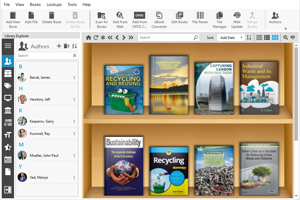5 books on Textile Recycling [PDF]
Updated: April 24, 2024 | 26 |
Books on Textile Recycling are invaluable resources for startups dedicated to advancing clothing and textile recycling, fostering sustainability, and minimizing the environmental impact of the fashion industry. These resources provide a comprehensive foundation, covering various aspects of textile recycling technologies, sustainable fashion practices, and circular economy principles. They delve into advanced techniques such as textile-to-textile recycling, upcycling, and sustainable material sourcing, emphasizing the importance of diverting textiles from landfills, reducing waste, and decreasing the carbon footprint of the textile and fashion sectors. Moreover, these books often include practical examples, case studies, and best practices, allowing startups to understand the intricacies of textile recycling projects and adapt these solutions to real-world applications.
1. Textile Recycling and Sustainable Apparel Designs
2023 by V.R. Sampath, Shamayita Patra, Pavan K. Gupta

The world currently grapples with a significant environmental challenge as synthetic non-biodegradable fibers constitute a substantial portion, around 60-70%, of the global fiber consumption, leading to widespread environmental pollution. Factors such as a growing world population, the rapid pace of fast fashion, increased production, and rising per capita consumption have culminated in a surge in textile waste production annually. Proper disposal of this waste has emerged as a pressing environmental dilemma, with both waste incineration and landfill dumping resulting in adverse environmental consequences. The most effective solution to combat waste disposal issues lies in embracing biodegradable fibers and implementing textile waste recycling by reusing clothing and household textiles, as well as regenerating fibers from discarded textiles. This transformative process emphasizes leveraging research, innovation, and knowledge across all facets of the industry, transcending business functions and subsectors, to promote textile recycling and foster sustainable apparel design. This book serves as a call to action, shedding light on the diverse facets of textiles at the local, regional, national, and global levels, all aimed at achieving these vital objectives. Furthermore, it provides insights into the latest trends and advancements in the field of recycling and sustainable apparel design.
Download PDF
2. Recycling from Waste in Fashion and Textiles: A Sustainable and Circular Economic Approach
2020 by Pintu Pandit, Shakeel Ahmed, Kunal Singha, Sanjay Shrivastava

With the environment facing a critical surge in greenhouse gases, the rapid depletion of natural resources, and the escalating volume of industrial waste, the imperative of sustainability now scrutinizes every facet of manufacturing. When diverse forms of waste, including clothing, furniture, carpets, electronics, footwear, paper, and food waste, culminate in landfills, only a fraction naturally decomposes, leaving the majority as non-biodegradable remnants. Consequently, concerted efforts are directed toward lightening the Earth's burden of waste, particularly in the realm of used textile products, where recycling and upcycling initiatives are gaining momentum. "Recycling from Waste in Fashion and Textiles" explores the pivotal role of sustainability in fashion and textiles by harnessing textile waste, addressing facets of manufacturing, materials, and the economic and business dynamics it entails. Comprising 19 comprehensive chapters, this book delves into an array of topics, encompassing sustainable solutions for the fashion and textile industry, the utilization of agro and bio waste in fashion, innovative approaches to fashion brands through textile waste, considerations of waste in handloom textiles, the paradigm shift in 21st-century fashion driven by recycling and upcycling, the sustainable application of natural waste for textile coloration, the circular economy in fashion and textiles derived from waste, future pathways for waste utilization in fashion, and sustainable methods for encapsulating natural dyes from plant waste for textile use, among other critical subjects in the pursuit of eco-friendly practices.
Download PDF
3. Stimulating Textile-to-Textile Recycling
2017 by David Watson, Maria Elander, Anja Gylling, Tova Andersson, Pirjo Heikkilä

Promoting the longevity of textile products takes precedence as a strategy to mitigate the environmental footprint of textile manufacturing. Nevertheless, once textiles reach the end of their usable life, recycling them into fresh textile products offers a significant environmental advantage over incineration or landfill disposal. Several Nordic brands have embarked on journeys toward textile-to-textile recycling, employing approaches such as designing products for recyclability to enhance the potential supply and incorporating recycled materials into new creations. This report evaluates the experiences of eleven such brands, documenting their motivations, the challenges they've encountered, and the strategies they've employed to surmount these obstacles. Simultaneously, it is released alongside a case wallet, with the intention of inspiring other brands to embrace closed-loop thinking.
Download PDF
4. Textiles and Clothing Sustainability: Recycled and Upcycled Textiles and Fashion
2016 by Subramanian Senthilkannan Muthu

In this book, an extensive exploration unfolds regarding the principles of recycling and upcycling, examining their profound significance within the textiles and fashion industry. While delving into the theoretical underpinnings of these concepts, the book simultaneously offers a diverse array of practical avenues for implementing recycling and upcycling techniques in the realm of textiles and fashion. While recycling is an established and widely practiced concept, the rising prominence of upcycling within this sector is also rigorously examined and discussed.
Download PDF
5. Recycling Indian Clothing: Global Contexts of Reuse and Value
2010 by Lucy Norris

In our interconnected global market, a wedding sari from rural north India can undergo a remarkable transformation, reemerging as a woman's blouse or a decorative cushion cover in a Western boutique. Lucy Norris's anthropological exploration into the recycling of clothing in Delhi unravels the journey of garments as they transition from being cherished gifts to being worn, handed down, discarded, recycled, and eventually resold. Within middle-class households, clothing gifts play a pivotal role in shaping and reshaping relationships. However, as the surplus of unwanted clothing continues to grow, it contributes to a widespread surplus of textile waste on a global scale. In scenarios where old clothing is exchanged for new household items, it enters a sprawling waste commodity system, wherein it may be resold to those in need or repurposed into fresh textiles for export. Norris meticulously traces the intricate web of local and international flows, traversing homes and markets, while spotlighting the individuals who navigate the often concealed realm of fabric recycling.
Download PDF
How to download PDF:
1. Install Google Books Downloader
2. Enter Book ID to the search box and press Enter
3. Click "Download Book" icon and select PDF*
* - note that for yellow books only preview pages are downloaded
1. Textile Recycling and Sustainable Apparel Designs
2023 by V.R. Sampath, Shamayita Patra, Pavan K. Gupta

The world currently grapples with a significant environmental challenge as synthetic non-biodegradable fibers constitute a substantial portion, around 60-70%, of the global fiber consumption, leading to widespread environmental pollution. Factors such as a growing world population, the rapid pace of fast fashion, increased production, and rising per capita consumption have culminated in a surge in textile waste production annually. Proper disposal of this waste has emerged as a pressing environmental dilemma, with both waste incineration and landfill dumping resulting in adverse environmental consequences. The most effective solution to combat waste disposal issues lies in embracing biodegradable fibers and implementing textile waste recycling by reusing clothing and household textiles, as well as regenerating fibers from discarded textiles. This transformative process emphasizes leveraging research, innovation, and knowledge across all facets of the industry, transcending business functions and subsectors, to promote textile recycling and foster sustainable apparel design. This book serves as a call to action, shedding light on the diverse facets of textiles at the local, regional, national, and global levels, all aimed at achieving these vital objectives. Furthermore, it provides insights into the latest trends and advancements in the field of recycling and sustainable apparel design.
Download PDF
2. Recycling from Waste in Fashion and Textiles: A Sustainable and Circular Economic Approach
2020 by Pintu Pandit, Shakeel Ahmed, Kunal Singha, Sanjay Shrivastava

With the environment facing a critical surge in greenhouse gases, the rapid depletion of natural resources, and the escalating volume of industrial waste, the imperative of sustainability now scrutinizes every facet of manufacturing. When diverse forms of waste, including clothing, furniture, carpets, electronics, footwear, paper, and food waste, culminate in landfills, only a fraction naturally decomposes, leaving the majority as non-biodegradable remnants. Consequently, concerted efforts are directed toward lightening the Earth's burden of waste, particularly in the realm of used textile products, where recycling and upcycling initiatives are gaining momentum. "Recycling from Waste in Fashion and Textiles" explores the pivotal role of sustainability in fashion and textiles by harnessing textile waste, addressing facets of manufacturing, materials, and the economic and business dynamics it entails. Comprising 19 comprehensive chapters, this book delves into an array of topics, encompassing sustainable solutions for the fashion and textile industry, the utilization of agro and bio waste in fashion, innovative approaches to fashion brands through textile waste, considerations of waste in handloom textiles, the paradigm shift in 21st-century fashion driven by recycling and upcycling, the sustainable application of natural waste for textile coloration, the circular economy in fashion and textiles derived from waste, future pathways for waste utilization in fashion, and sustainable methods for encapsulating natural dyes from plant waste for textile use, among other critical subjects in the pursuit of eco-friendly practices.
Download PDF
3. Stimulating Textile-to-Textile Recycling
2017 by David Watson, Maria Elander, Anja Gylling, Tova Andersson, Pirjo Heikkilä

Promoting the longevity of textile products takes precedence as a strategy to mitigate the environmental footprint of textile manufacturing. Nevertheless, once textiles reach the end of their usable life, recycling them into fresh textile products offers a significant environmental advantage over incineration or landfill disposal. Several Nordic brands have embarked on journeys toward textile-to-textile recycling, employing approaches such as designing products for recyclability to enhance the potential supply and incorporating recycled materials into new creations. This report evaluates the experiences of eleven such brands, documenting their motivations, the challenges they've encountered, and the strategies they've employed to surmount these obstacles. Simultaneously, it is released alongside a case wallet, with the intention of inspiring other brands to embrace closed-loop thinking.
Download PDF
4. Textiles and Clothing Sustainability: Recycled and Upcycled Textiles and Fashion
2016 by Subramanian Senthilkannan Muthu

In this book, an extensive exploration unfolds regarding the principles of recycling and upcycling, examining their profound significance within the textiles and fashion industry. While delving into the theoretical underpinnings of these concepts, the book simultaneously offers a diverse array of practical avenues for implementing recycling and upcycling techniques in the realm of textiles and fashion. While recycling is an established and widely practiced concept, the rising prominence of upcycling within this sector is also rigorously examined and discussed.
Download PDF
5. Recycling Indian Clothing: Global Contexts of Reuse and Value
2010 by Lucy Norris

In our interconnected global market, a wedding sari from rural north India can undergo a remarkable transformation, reemerging as a woman's blouse or a decorative cushion cover in a Western boutique. Lucy Norris's anthropological exploration into the recycling of clothing in Delhi unravels the journey of garments as they transition from being cherished gifts to being worn, handed down, discarded, recycled, and eventually resold. Within middle-class households, clothing gifts play a pivotal role in shaping and reshaping relationships. However, as the surplus of unwanted clothing continues to grow, it contributes to a widespread surplus of textile waste on a global scale. In scenarios where old clothing is exchanged for new household items, it enters a sprawling waste commodity system, wherein it may be resold to those in need or repurposed into fresh textiles for export. Norris meticulously traces the intricate web of local and international flows, traversing homes and markets, while spotlighting the individuals who navigate the often concealed realm of fabric recycling.
Download PDF
How to download PDF:
1. Install Google Books Downloader
2. Enter Book ID to the search box and press Enter
3. Click "Download Book" icon and select PDF*
* - note that for yellow books only preview pages are downloaded


